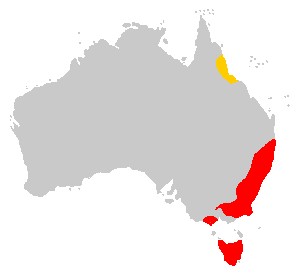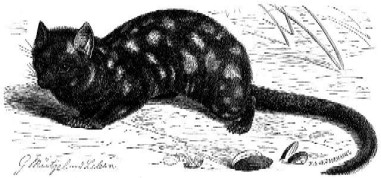Extinct Quoll Rediscovered on Mainland?
Posted by: Loren Coleman on November 3rd, 2006
Click on the Eastern Quoll (Dasyurus viverrrinus) above for a full sized image.
"Extinct" marsupial may be alive and well – NSW
Rebecca Lang
A Hawkesbury (NSW, Australia) resident may have stumbled upon one of the most exciting zoological finds of the decade – a small marsupial previously thought to be extinct on Australia’s mainland.
East Kurrajong resident and Hawkesbury Gazette newspaper employee Nicole Palmer was driving along Roberts Creek Road recently when she spotted a couple of unusual-looking animals.
"There was two of them. One was smaller. I pulled up and the larger one kept hopping towards the car so I strated rolling back down the hill and honking my horn," she said.
"They were both dark brown with white spots around its jowl and neck area, 3-4 inches of the tip of its tail was white and it didn’t look like a tiger quoll, it was much smaller and less heavy."
From her description, NPWS ranger Vickii Lett and University of Western Sydney biologist Professor Rob Close believe Ms Palmer may have spotted two Eastern quolls.
Eastern quolls are about the size of domestic cats with pointed noses and soft fawn, brown or black-coloured fur broken up by white spots, and a bushy tail with a white tip.
They are much smaller than their cousins, the endangered Spotted-tail or ‘Tiger’ quoll, which has a coarse, reddy-brown coat with white spots and is half as big again as the eastern quoll.
The eastern quoll was last sighted on the mainland in the 1960s in the Sydney suburb of Vaucluse.
Since that time dogs, cats and people have encroached on the small marsupial’s habitat to the extent that they are now believed to be extinct on the mainland.
However, Eastern quolls remain prolific in Tasmania, preferring to live in dry grassland and forest bordering farm paddocks.
Ms Lett said National Parks would be acting on the sighting of the protected species.
"We’ll talk to Dr Rob Close at UWS and see what we can do," she said.
"In the meantime, we’d like residents to keep an eye out and if they see something unusual, take a picture of it with their camera or mobile phone.
"We’d also like people in the area to be careful about letting their dogs and cats roam around."
Dr Close, who recently urged residents to keep an eye out for signs of rare wildlife, said he was thrilled about the sighting.
"If it is in fact a true sighting, it’s very exciting," Dr Close said.
"There’s been a few sightings over the past few years, unverified, so it raises hopes that they are still around.
"If they can live in Vaucluse until the ’60s, you’d think there would be a chance they could survive in these more isolated places.
"Nobody knows what knocked the eastern quolls off. Disease was a possibility, and if that’s all over now, their numbers could be building up again."
The finding was made in late October.
Source: Hawkesbury Gazette, Wednesday, 1 November 2006

About Loren Coleman
Loren Coleman is one of the world’s leading cryptozoologists, some say “the” leading living cryptozoologist. Certainly, he is acknowledged as the current living American researcher and writer who has most popularized cryptozoology in the late 20th and early 21st centuries.
Starting his fieldwork and investigations in 1960, after traveling and trekking extensively in pursuit of cryptozoological mysteries, Coleman began writing to share his experiences in 1969. An honorary member of Ivan T. Sanderson’s Society for the Investigation of the Unexplained in the 1970s, Coleman has been bestowed with similar honorary memberships of the North Idaho College Cryptozoology Club in 1983, and in subsequent years, that of the British Columbia Scientific Cryptozoology Club, CryptoSafari International, and other international organizations. He was also a Life Member and Benefactor of the International Society of Cryptozoology (now-defunct).
Loren Coleman’s daily blog, as a member of the Cryptomundo Team, served as an ongoing avenue of communication for the ever-growing body of cryptozoo news from 2005 through 2013. He returned as an infrequent contributor beginning Halloween week of 2015.
Coleman is the founder in 2003, and current director of the International Cryptozoology Museum in Portland, Maine.











Interesting, and maybe informative about how certain critters can live under our noses and NOT be detected for a long time, but I’m more interested in creatures who’s entire existence is questioned.
Good news if true, and I suspect it is. In my experience most people have no clue as to what wildlife lives alongside them. Hope they can prove this and that actions to protect them.
I think as we encroach more on the wilderness we will find more so called extinct or crypto species. There’s an amatuer botanist who featured on either NPR or Coast-to-Coast AM a few years ago who in his travels as truck driver dicovered dozens of species. He did this by going back to secluded canyons in the Sierra Neveda Mts that he would drive by during his truck travels. There are many college-educated botanist today who are lucky to have discovered one new species much less dozens. I’ve heard a great many closed minded scientist who believe that they are skilled enough to find cryptids like Bigfoot when they spend less time outside the classroom/lab than inside. If anyone can or will confirm the existence of many cryptids, they’ll probably be a hunter, rancher or farmer not a ‘wildlife biologist’.
I hope this is for real and they can get a photo and protect the little guys.
Cool Man! The discovery of any cryptid is great, but finding the creatures we though we killed off…even better in my book.
Wonderful news! Hopefully they can photographic evidence, and of course we want protection for them! This gives me hope for the thylacine yet!
That’s great news. Megamouth shark, ivory billed woodpecker,and the coelacanth, just to name a few, were all thought to have gone extinct. There are all kinds of animals around the world that only live in certain places and found NOWHERE else on the planet. Can you imagine how many things have not been discovered in the Congo, the jungles of Indonesia, and even our own national forests. And if creatures only thrive in those locations, the only way they will ever be discovered is if SOMEONE GOES IN THERE TO FIND THEM.
I find it interesting that the officials seem so much less hostile about this sighting than they would be over a Tasmanian Tiger sighting.
Cor2879, I was thinking excactly the same thing. Couldn’t have said it better myself.
Seems to me that these days new species, and species previously thought extinct are being discovered and re-discovered at a greater rate than any time in history. Causes-Global Warming-Destruction of Rainforests-More interest in this sort of thing-End Times around the corner. Anyone have thoughts on this. Loren, what do you think?
“cor2879 Says:
I find it interesting that the officials seem so much less hostile about this sighting than they would be over a Tasmanian Tiger sighting.”
I think that such a mindset is understandable to an extent. After all, eastern quolls are still common on the island of Tasmania, but the thylacine is considered to be extinct everywhere.
And once again a faint flicker for the Tazzie Tiger, Just Maybe.
I totally missed this article on Cryptomundo! (but I caught the original at the Gazette)
Shortly after this article was published I wrote short piece about my own background with Eastern quolls, and presently I have just finished a new article summarising my own search for the Eastern quoll – just this weekend – at the same location reported by Nicole Palmer.
A word of warning though – unsurprisingly, I didn’t find any! 😀 But my capacity to search on foot was also somewhat limited.
Nevertheless, the bird life in the world famous Wollemi National Park is amazing!
Chris
kittenz – it may be understandable that a mainland Eastern quoll sighting is treated with much less “hostility” – but possibly not just because they are still common in Tasmania.
Mainland Eastern quolls haven’t been confirmed on the mainland in 43 years (compared to the thylacine’s 70) and the Eastern quoll is about the size of a small cat, whilst the thylacine is about the size of a dog.
All the same, credible thylacine sightings are investigated too.